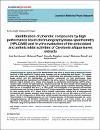Identification of phenolic compounds by HPLC/MS and in vitro evaluation of the antioxidant and antimicrobial activities of Ceratonia siliqua leaves extracts
| Author | Hsouna, Anis Ben |
| Author | Trigui, Mohamed |
| Author | Jarraya, Raoudha Mezghani |
| Author | Damak, Mohamed |
| Author | Jaoua, Samir |
| Available date | 2015-12-28T11:35:46Z |
| Publication Date | 2015-04-10 |
| Publication Name | Journal of Medicinal Plants Research |
| Citation | Hsouna A. , Trigui, M. , Jarraya, R. , Damak, M. , Jaoua, S. (2015). "Identification of phenolic compounds by high performance liquid chromatography/mass spectrometry (HPLC/MS) and in vitro evaluation of the antioxidant and antimicrobial activities of Ceratonia siliqua leaves extracts", Journal of Medicinal Plants Research, Vol. 9(14), pp. 479-485, |
| ISSN | 1996-0875 |
| Identifier | 056640E52580 (Article Number) |
| Abstract | Ceratonia siliqua is a typical plant of the Mediterranean area, which is mainly used as animal and human food and in folk medicine for treating some diseases such as antidiarrheal and diuretic. The present study was planned to evaluate the potential of antimicrobial and antioxidant activities of C. siliqua leaves extract and the identification of bioactive compounds by high performance liquid chromatography/mass spectrometry (HPLC/MS) in the active extract. The antioxidant activities of the different organic extracts of C. siliqua were assayed by 2,2-diphenyl-l-picrylhydrazyl (DPPH) and β-carotene tests. Among the tested extracts, results showed that the ethyl acetate extract displayed the greatest DPPH scavenging ability with an IC50 of 1.8 µg/ml and a strong β-carotene bleaching inhibition after 120 min of incubation with an IC50 of 24.01 µg/ml. The investigation of the phenolic and flavonids content showed that the ethyl acetate extract of C. siliqua revealed the highest phenolic contents. Only the ethyl acetate extract of C. siliqua (EACs) showed antimicrobial activity with a broad-spectrum microbiocide with diameter inhibition zones ranging from 12 to 24 mm and MIC values of 0.312 to 1.25 mg/ml. The HPLC finger print of EACs active extract showed the presence of six phenolic compounds. They included (1) 1,6-Di-galloyl-glucose, (2) 1,2,6-Tri-galloyl-glucose, (3) Myricetin glucoside, (4) 1,2,3,6-Tetra-galloyl-glucose, (5) Myricetin rhamnoside and (6) Syringic acid. These results are a good agreement of the popular use and experimentally observed effects of C. siliqua and would promote the reasonable usage and exploitation of the biomolecules of this important plant. |
| Language | en |
| Publisher | Academic Jounals |
| Subject | Ceratonia siliqua Chemical composition Antimicrobial activity Antioxidant activity Phenolic compounds |
| Type | Article |
| Pagination | 479-485 |
| Issue Number | 14 |
| Volume Number | 9 |
Files in this item
This item appears in the following Collection(s)
-
Biological & Environmental Sciences [791 items ]


